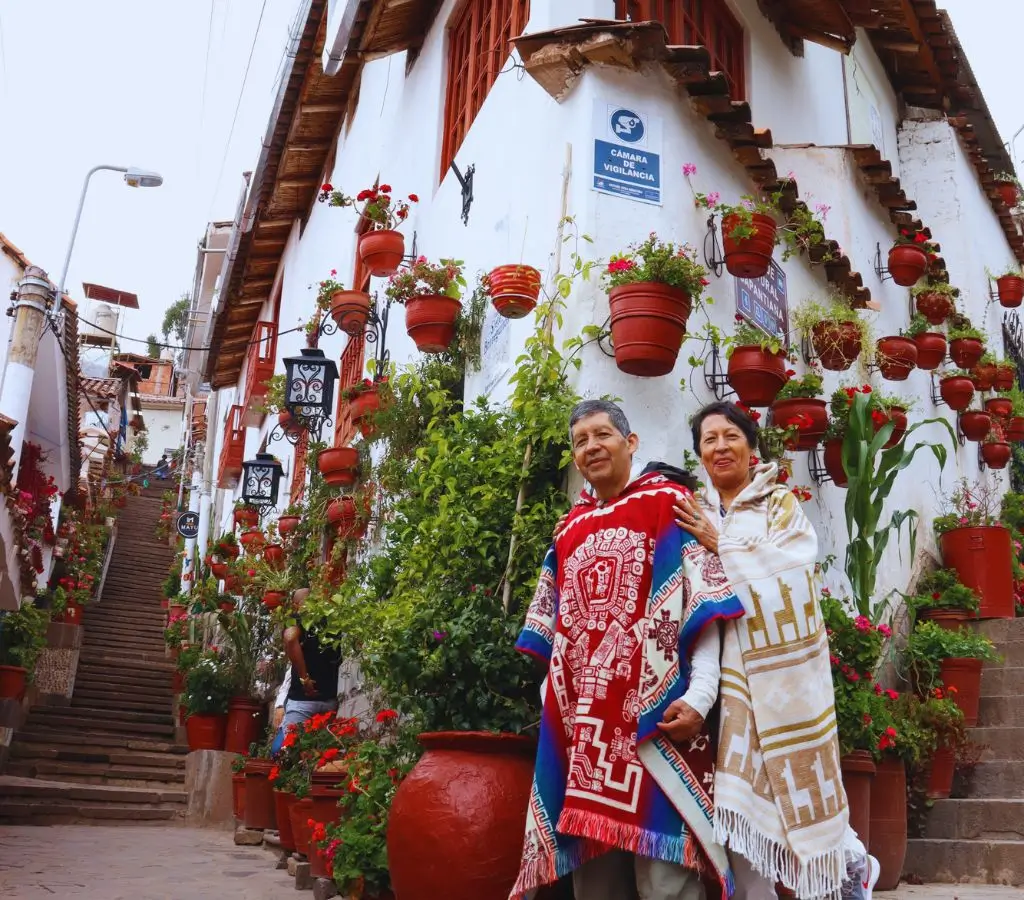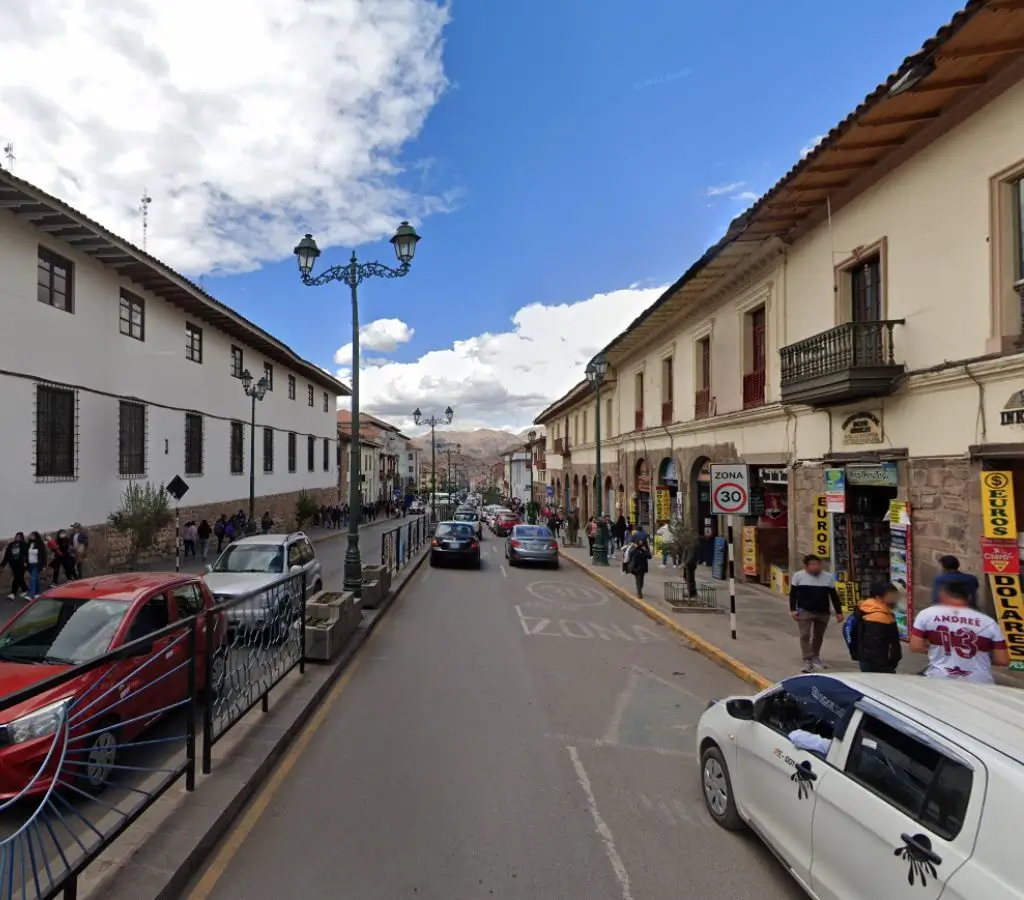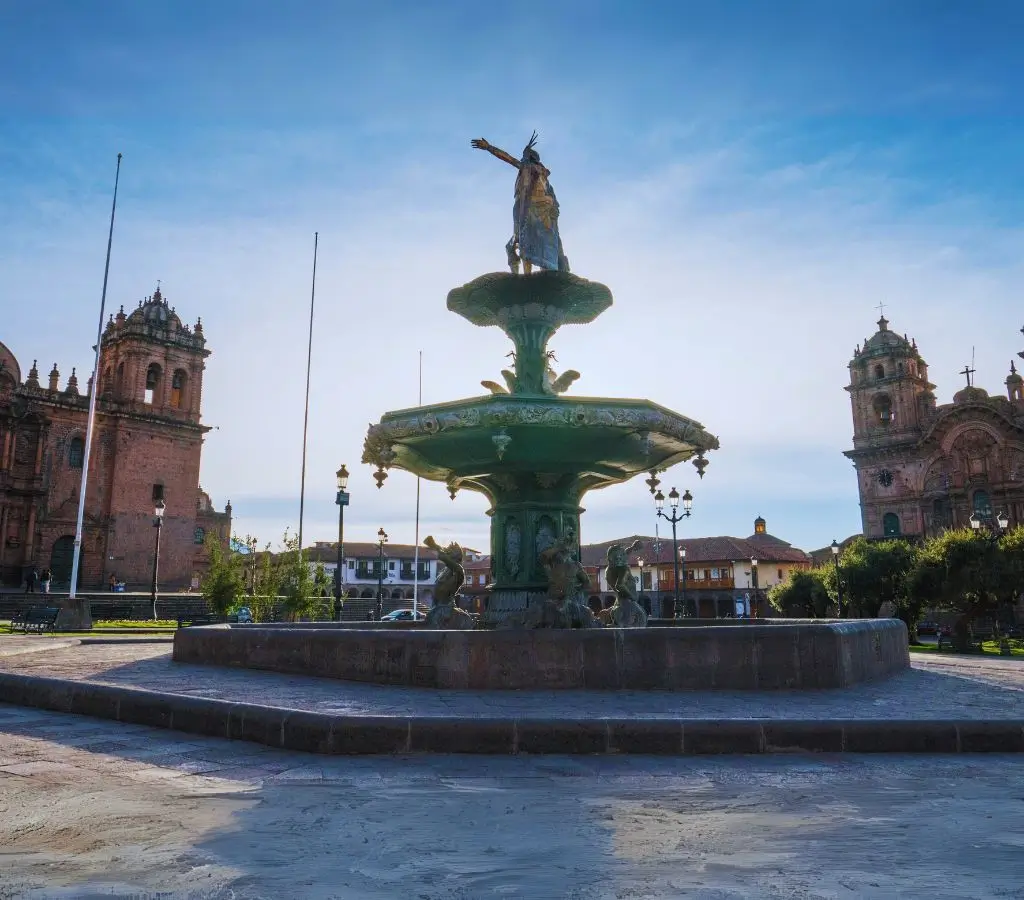Walk through the fascinating streets of Cusco, where every corner has its own story; explore its colonial architecture and narrow alleys full of tradition and culture, including the following:
Cusco, the former capital of the Inca Empire, impresses visitors with its streets full of history and mystery; from the Inca era to the arrival of the Spanish in the 16th century, its streets have witnessed key events that shaped the city's fate and all of South America.
The streets of Cusco were carefully designed and reflect the order and grandeur of the Inca Empire; with the arrival of the colonizers, they transformed into a space that merges colonial style with ancestral footprints. Today, walking through its streets is a journey through time, where the past and present intertwine in a vibrant city full of legends.
Today, we will explore the most iconic streets of Cusco, such as Hatun Rumiyoc, famous for the "Stone of the 12 Angles," and the vibrant San Blas Hill, the artistic center of the city.
We will also explore the mysterious Calle Siete Borreguitos, the historic Calle Loreto, and the bustling Avenida El Sol, the economic and tourist heart of Cusco; each street offers a unique story that reveals the essence of the city.
Hatun Rumiyoc Street, in the heart of Cusco, is famous for the "Stone of the 12 Angles," a masterpiece of Inca engineering. This stone, with its perfectly fitted angles, remains a symbol of Inca architectural skill.
Beyond its architectural significance, the street holds deep cultural and spiritual meaning for the people of Cusco. It is a living testimony of this civilization's legacy.
San Blas Hill, the artistic and cultural hub of Cusco, is known for being the neighborhood of artists, full of workshops and galleries; its cobbled streets and bohemian atmosphere create a vibrant space where music and art flourish.
It is a place of inspiration for creators and visitors from around the world.
Calle Siete Borreguitos, with its rich tradition and legends, is a magical and mysterious place in Cusco; it is a valued meeting and leisure spot for locals and visitors alike.
Today, it has become one of the most touristy streets, standing out for its flowered balconies that offer peace and tranquility amidst the hustle and bustle of the city. It’s an ideal place to visit and take beautiful photos.

Calle Loreto is an important historical and religious point in Cusco, known for its colonial mansions and architectural value; it is home to the Jesuit Church, a complex combining colonial and baroque styles.
Beyond its religious importance, the street has an Inca background as it was part of the palace of Huayna Capac, Amaru Cancha, making it a key place that connects Cusco's Inca and colonial past.
Avenida El Sol is the main economic and tourist center of Cusco, connecting the past with the present. Along it, there are shops, restaurants, and hotels that reflect the city's cultural diversity.
Additionally, the avenue features the largest mural in Latin America, which tells the history of Cusco, offering a key reference for understanding its evolution.

Discover the most notable plazas of Cusco, authentic urban gems that not only beautify the city but also stand witness to its rich history and tradition; each plaza has its own character and significance, reflecting the influence of the civilizations that inhabited the region, from the Incas to the colonial era.
Plaza de Armas of Cusco, also known as "Huacaypata" in Inca times, is the historic and cultural heart of the city, surrounded by majestic colonial buildings such as the imposing Cusco Cathedral and the Church of the Company of Jesus. This plaza is a symbol of the architectural grandeur and cultural richness that characterizes the former capital of the Inca Empire.
Since ancient times, Plaza de Armas has witnessed transcendental events in Cusco's history, serving as a gathering, celebration, and protest site for its residents and visitors; today, it remains the main focal point of the city where tourists and locals congregate to enjoy its architectural beauty and vibrant atmosphere.
Visiting Plaza de Armas is to immerse oneself in the very essence of Cusco and feel the force of its history pulse in every stone and every corner of this iconic place.

Plaza Regocijo, also known as "Huacaypata" during the Inca era, is the historical and cultural center of the city, surrounded by colonial buildings such as the Cusco Cathedral and the Church of the Company of Jesus. Reflecting the architectural grandeur of the former Inca capital.
Throughout history, it has been the scene of key events and remains the main meeting point in the city today. It’s a vibrant place where tourists and locals enjoy its beauty and the rich history it conveys.
Plaza Santo Domingo is an example of the "Fusion of Styles," where Inca architecture blends with Spanish colonial style. This combination creates a unique and fascinating urban landscape.
Facing the Temple of Qorikancha, the plaza reflects the union between two cultures, with Inca ruins and baroque churches coexisting, creating a peaceful and beautiful space in the heart of the city.
Plaza de San Blas, located in the neighborhood of the same name, is the artistic center of Cusco; this place, known as the "Artists' Neighborhood," brings together painters, sculptors, artisans, and musicians.
Surrounded by workshops and galleries, the plaza is a creative meeting point where artists display their work. Here, Cusco’s culture comes to life in every corner.
Visiting Plaza de San Blas is diving into local art and discovering the passion that defines this vibrant space.
Plaza de San Cristóbal, a viewpoint in Cusco, offers stunning views of the city and the Andes, making it a unique place to enjoy the area's natural beauty.
This site has become a gathering point for locals and tourists, where people come to watch the sunset and take photos.
Visiting the plaza is a must-do experience for anyone who wants to see Cusco from another perspective; its panoramic view is simply unmatched.
Walk through the emblematic streets of Cusco, where each one reflects the ancient history of the city, these charming and culturally rich streets attract those seeking to connect with the past.
Cuesta de la Amargura, known as the "Path to Sacrifice," was a place where the natives had to stop falling stones from the top, causing injuries and deaths, which is how it got its name.
In Inca times, this steep hill was used for religious ceremonies and sacrifices to the gods. Today, its ancient steps invite visitors to reflect on the history and spirituality of Cusco.
Calle 7 Diablitos, known for its mysterious name, has an origin related to young lovers rather than supernatural phenomena; its fame comes from romantic encounters that led to rumors about pregnancies.
Far from these beliefs, the street retains an ancient charm, with its quiet and narrow atmosphere, inviting a peaceful walk. It’s a reflection of the ancient Inca streets, full of history.
Near it is the Plaza de San Blas, with its local art and restaurants offering traditional Cusco food. Although little frequented, it remains a place where the tradition of romantic encounters endures.
In the center of Cusco, Calle Siete Culebras connects Inca and colonial history, surrounded by the Monastery of Las Nazarenas and the Church of San Antonio Abad. It is a cobbled street known for its narrowness.
Previously called 'Amaru ccata', its name refers to serpent carvings on the walls. This Inca symbolism remains, reflecting the city's ancestral heritage.
The street showcases a blend of architectural styles, from Inca mastery to colonial influence. Visitors can enjoy this historical fusion while exploring the surroundings of Cusco.
The Spanish named the street "Resbalosa" because of its steep slope and slippery stones, especially on rainy days. This feature made it famous for its difficulty.
During Inca times, the street was known as "Sikitakana", meaning "you hit your backside". During colonial times, it became a place for bravery competitions among young people.
The competitions, called "resbalosa races", became popular as a local challenge. Over time, the street transformed into a symbol of Cusco’s identity.
Today, Calle Resbalosa remains a popular spot. Although the slippery stones have been replaced with cobblestones, it still maintains its historical appeal and is a meeting point for locals and tourists.
Calle del Almirante, located in the center of Cusco, honors Admiral Francisco Alderete Maldonado, who lived in the house until his death. Its history is also tied to the palace of Emperor Huáscar during the Inca period.
This street connects Plaza de Armas to Plazoleta de las Nazarenas, maintaining the layout of Inca streets. Today, the Admiral's House houses the Inca Museum, an important historical site.
The modern avenues and streets of Cusco combine the city's history with current comforts, respecting its cultural heritage. This urban design offers visitors a unique experience.
In these streets, you’ll find craft shops, restaurants, and boutique hotels, alongside Inca and colonial buildings. Additionally, the road infrastructure has been improved to facilitate traffic without losing its natural beauty.
The modern avenues and streets of Cusco combine the city's history with current comforts, respecting its cultural heritage. This urban design offers a unique experience for visitors.
In these streets, you’ll find craft shops, restaurants, and boutique hotels, alongside Inca and colonial constructions. Additionally, the road infrastructure has been improved to facilitate traffic while maintaining natural beauty.
Avenida Pardo, or "Paseo de los Héroes", is an important street in Cusco known for its architecture and gardens. Monuments dedicated to six national heroes are found here.
This promenade is a patrimonial treasure, representing the "Republican Era" of the city. Over the years, it has gone from being "La Alameda" to becoming an important historical landmark.
Calle Santa Clara is a symbol of Cusco's history, having been the site of significant events, from religious celebrations to political occurrences. Its presence has been key in the city's evolution.
Over the years, the street has undergone transformations, reflecting Cusco's cultural and social changes. Its architecture and economic activities are witnesses to its development.
What makes it unique is how it preserves its historical essence while adapting to the present. Its colonial charm and mystical atmosphere make it a special place to explore.
Cusco, a historic city in Peru, is full of emblematic streets that reflect its rich cultural and architectural heritage. Some of the most prominent streets include:
Calle Hatun Rumiyoc is famous for the "Stone of the 12 Angles", a standout example of Inca mastery in construction. It also houses the Archbishop's Palace, reflecting the fusion of Inca and colonial architecture. The stone highlights the skill of the Incas in stone carving.
Avenida El Sol is one of Cusco's main thoroughfares, connecting key sites like Plaza de Armas and the Temple of the Sun (Qorikancha). It is notable for its shops, restaurants, and the constant activity that characterizes it. This avenue reflects the vitality and dynamism of the city.
Calle de la Plata is famous for its silver craft shops, making it an ideal place to buy handmade jewelry and other local products. It's the perfect spot for those looking for authentic and unique souvenirs from Cusco.
Calle del Triunfo, named for the Triumph Arch near the Cusco Cathedral, is a key route to Plaza de Armas from the San Blas neighborhood. This street, filled with shops, restaurants, and hotels, is a bustling point of activity.
Calle San Blas, located in the heart of the bohemian San Blas neighborhood, is known for its colonial architecture and artistic atmosphere. With artist workshops, art galleries, and cultural events, it’s a vibrant and creative place. At the end of the street, Plaza San Blas offers an ideal space to enjoy local culture and admire the Church of San Blas.
Cusco, with its rich culture and colonial architecture, captivates visitors. Its cobblestone streets, which tell stories of the past, reflect the fusion of Inca heritage and Spanish influence. Below, we answer some frequently asked questions about the streets:
Avenida El Sol is the main street of Cusco, a key artery running through the city center. In addition to being the main access for visitors, this street symbolizes the division between Cusco's Inca past, its colonial present, and modern developments.
Plaza de Armas, also known as Plaza Mayor, is the vibrant heart of Cusco. Surrounded by impressive colonial buildings, such as the Cathedral and the Church of the Society of Jesus, it radiates history and beauty.
It’s the perfect place to dive into Cusco’s culture, from folk music and crafts to Sunday cultural performances.
Getting to Plaza de Armas in Cusco is easy, as it’s in the city center. If you’re staying in the historic area, you can probably walk to the square, enjoying the cobbled streets and colonial facades along the way.
For those coming from other parts of the city or who prefer quicker transportation, taxis are a convenient option. Cusco has a wide availability of taxis, but it’s important to agree on the price before getting in to avoid surprises at the end of the trip.
Don't hesitate to ask locals about Plaza Mayor or any other direction, as Cusqueños are friendly and always ready to help. Their hospitality and willingness will make you feel warmly welcomed.


